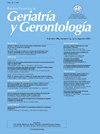Aceptación e intención de uso de una camiseta con sensores fisiológicos en el ámbito de la salud en pacientes mayores
Q3 Medicine
引用次数: 0
Abstract
Objectives
To assess the acceptance and intention to use physiological sensor shirt among older patients in healthcare, as well as to identify the factors that encourage a positive attitude towards its adoption.
Methods
Cross-sectional study using questionnaires addressed to patients between 60 and 85 years of age, administered via face-to-face interviews to determine intention to use a shirt with physiological sensors. The extended version of the Technology Acceptance Model (TAM) questionnaire was used in conjunction with administration of the quality of life and perceived stress scales.
Results
Forty-eight patients participated in the study, 54.2% were male with a mean age of 70.5 years. The mean scores for attitude towards use and intention to use were 3.9 (SD: 0.8) and 3.3 (SD: 0.8), respectively, out of a maximum of 5. The willingness to use the device was positive in 72.9% of patients The patients intending to use wearable technology (n = 35) scored significantly higher than those unwilling to wear the shirt (n = 13) on perceived ubiquity (P = .031), perceived ease of use (P = .002), and perceived utility (P = .007).
Conclusions
In a sample of independent older adults from the healthcare sector, a high willingness to use a shirt with physiological sensors was found. Through the TAM questionnaire, ubiquity, perceived ease of use, and perceived usefulness were identified as key factors predisposing its adoption.
[老年患者对健康领域生理传感器衬衫的接受程度和使用意向]。
目的评估医疗机构中老年患者对生理传感器衬衫的接受程度和使用意向,并确定鼓励对其采用积极态度的因素:横断面研究:通过面对面访谈的方式,向 60 至 85 岁的患者发放问卷,以确定他们是否有意使用带有生理传感器的衬衫。研究使用了技术接受模型(TAM)的扩展版问卷,并使用了生活质量和感知压力量表:48名患者参与了研究,其中54.2%为男性,平均年龄为70.5岁。使用态度和使用意愿的平均分分别为 3.9(标度:0.8)和 3.3(标度:0.8),满分为 5 分。有意使用可穿戴技术的患者(35 人)在感知到普遍性(P=.031)、感知到易用性(P=.002)和感知到实用性(P=.007)方面的得分显著高于不愿意穿衬衫的患者(13 人):在医疗保健行业的独立老年人样本中,发现他们非常愿意使用带有生理传感器的衬衫。通过 TAM 问卷调查,普遍性、感知易用性和感知有用性被认为是促使其被采用的关键因素。
本文章由计算机程序翻译,如有差异,请以英文原文为准。
求助全文
约1分钟内获得全文
求助全文
来源期刊

Revista Espanola de Geriatria y Gerontologia
Medicine-Medicine (miscellaneous)
CiteScore
1.90
自引率
0.00%
发文量
62
审稿时长
85 days
期刊介绍:
Una revista de gran prestigio por sus artículos originales de investigación y revisiones. Permite cubrir todas las áreas de la medicina pero siempre desde la atención al paciente anciano, y está presente en los más reconocidos índices internacionales.
 求助内容:
求助内容: 应助结果提醒方式:
应助结果提醒方式:


